An interview with Paula Kahumbu of WildlifeDirect.
Rising over 2,500 meters from Kenya’s northern desert, the Mathews Range is a sky island: isolated mountain forests surrounded by valleys. Long cut off from other forests, ‘sky islands’ such as this often contain unique species and ecosystems. Supported by the Nature Conservancy, an expedition including local community programs Northern Rangelands Trust and Namunyak Conservancy recently spent a week surveying the mountain range, expanding the range of a number of species and discovering what is likely a new insect.
“It’s really off the beaten track and few people have ever been there because access has been extremely poor until a tarmac road was constructed in recent months,” says Paula Kahumbu, Executive Director of WildlifeDirect, in a recent interview with mongabay.com. Kahumbu was a member of the expedition. Prior to the construction of the road, which was built by oil companies, the mountains were only accessible by camel or helicopter.
“It is thought that the Mathews range may hold the secretes to many new species because this sky island formed over 10 million years ago separating it from other forested areas allowing sufficient time for evolution to lead to speciation,” Kahumbu explained, adding that given new development pressures on the region “the expedition was to establish a baseline of species, to look for new species, and to determine the conservation benefits of saving this spectacular mountain.”
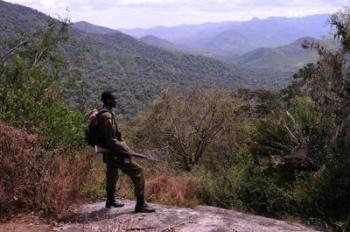 The forests of Mathews Range. Photo courtesy of: Paula Kahumbu. |
During the expedition, researchers found what is likely a new species of weevil.
“[The weevil] was extracted from the endemic cycad, an ancient palm. As the palm is only found here, it’s likely that it is a pollinator,” says Kahumbu. The palm, known as Mathews cycad, is a relic of the Jurassic period.
“The tree is found only here making these forests particularly unique. We saw specimens that were estimated to be over 800 years old. The seeds are dispersed by elephants and the flowers are pollinated by [the] unique weevil, which just goes to demonstrate how closely interlined the plants and animals are.”
Still, the expedition was surprised that only one likely new species was discovered.
“To be honest, the biggest surprise was the dearth of species and low numbers of animals. Night after night the small mammal traps came up empty, and the diversity of bats was also low. The butterfly diversity was not as high as expected, and the reptiles were few, amphibians even fewer,” Kahumbu says. “The expedition suggested that the findings were not representative as Kenya has just emerged from a severe drought which might explain it.”
However, world-renowned conservationist Richard Leakey suggests that the Mathews Range “may have started off being species rich many tens of thousands of years ago, but with climate change it has experienced devastating droughts and each time losing those species adapted to the wettest parts of the forest.”
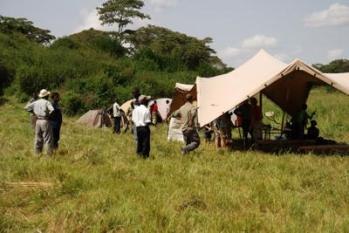 Researchers camp in the Mathews Range. Photo courtesy of: Paula Kahumbu. |
Whatever the cause of the unexpected low species abundance, the researchers did find a number of species that had not been recorded in northern Kenya previously.
While Kahumbu says the oil road has brought researchers to the Mathews Range for the first time, it also threatens the future of the forests.
“So far the impact on the forests has been minimal, but it is clear that the road could be a godsend or a disaster. Logging trucks use the road to exploit the forests and decimate them as has happened in other areas. Alternatively, the road could lead to economic benefits for the communities who live in the area and for tourism development. The Mathews have been left alone precisely because they have been inaccessible.”
Currently unprotected by the government of Kenya, the region of the Mathews Range is home to the Samburu people. These nomadic pastoralists have long-used the forests sustainably, but Kahumbu worries that is changing.
“The Samburu are both protectors and a threat. Their traditional way of life holds great respect for nature, but they are increasingly squeezed due to population growth and development, and some aspects of their tradition are outright detrimental. For example boys are encouraged to kill lions, which is destroying one of their most sellable assets for tourism. And women are not schooled and are encouraged to marry young thus entrenching poverty. In addition their aspirations are understandably changing and so too will their culture.”
In an August 2010 interview with mongabay.com, Paula Kahumbu talks about a recent expedition to Kenya’s sky island, including unique species, rising threats, and working with local tribes.
INTERVIEW WITH PAULA KAHUMBU
Mongabay: What is your background?
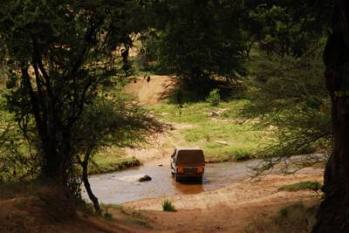 Expedition crosses river in northern Kenya. Photo courtesy of: Paula Kahumbu. |
Paula Kahumbu: I was born and raised in Kenya which might explain my love and passion for the wilderness. I’m an ecologist and I now run WildlifeDirect a charity that helps raise awareness about conservation organizations across Africa and Asia through blogging.
Mongabay: How did you become a member of the expedition to the Mathews Range?
Paula Kahumbu: I went to the Mathews range to assist on the production of a BBC news piece about the exciting expedition.
MATHEWS RANGE
Mongabay: Many people have probably never heard of the Mathews Range. What is this place?
Paula Kahumbu: The Mathews Range is a remote mountain range in Northern Kenya. It formed millions of years ago as a fault mountain and rises up to 2,688m above sea level. It’s really off the beaten track and few people have ever been there because access has been extremely poor until a tarmac road was constructed in recent months. Northern Kenya is a desert, but dotted here and there are mountains high enough to support tropical forests and the Mathews is the largest such mountain range.
Mongabay: Why was the Mathews Range a target for a biodiversity expedition?
Paula Kahumbu: It is thought that the Mathews range may hold the secretes to many new species because this sky island formed over 10 million years ago separating it from other forested areas allowing sufficient time for evolution to lead to speciation. While at the same time this forest is at risk due to the recent opening up of northern Kenya. Northern Kenya is being opened up for mineral exploration especially for oil. This means that untouched wilderness like the Mathews Range is increasingly exposed, visited and exploited by the growing number of people travelling through the area. The Expedition was to establish a baseline of species, to look for new species, and to determine the conservation benefits of saving this spectacular mountain.
Mongabay: Could new species be found in this area? Any discovered in this expedition so far?
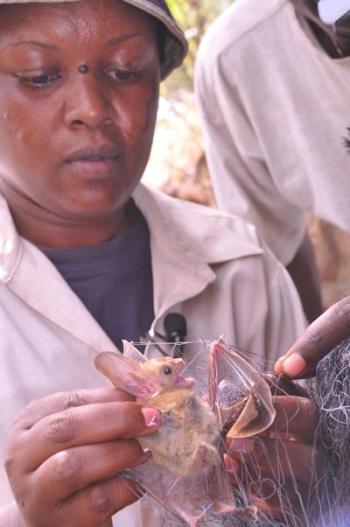 Researcher examines a false vampire bat from Mathews Range. Photo courtesy of: Paula Kahumbu. |
Paula Kahumbu: New species are expected in the area although so far the findings were of species formerly not known this far north in Kenya. For species that can move easily we might not expect much speciation to have occurred, but when a species becomes trapped on a sky island for millennia new species could evolve.
For example I would expect to see new species amongst groups that are restricted to the streams, many invertebrates, fish, frogs, and reptiles are likely to be unique. Nothing popped out at us except a weevil that was extracted from the endemic cycad, an ancient palm. As the palm is only found here, it’s likely that it is a pollinator, this weevil found by Quentin Luke and Dino Martins. It should, in fact, be a new species but they have to examine it closely in the lab to be certain.
Mongabay: What were some of the biological surprises in the expedition?
Paula Kahumbu: To be honest, the biggest surprise was the dearth of species and low numbers of animals. Night after night the small mammal traps came up empty, and the diversity of bats was also low. The butterfly diversity was not as high as expected, and the reptiles were few, amphibians even fewer. The expedition suggested that the findings were not representative as Kenya has just emerged from a severe drought which might explain it.
But Richard Leakey has a different explanation, he believes that this sky island may have started off being species rich many tens of thousands of years ago, but with climate change it has experienced devastating droughts and each time losing those species adapted to the wettest parts of the forest. This he said would lead to an overall decline in species diversity over a time frame too short for speciation to have balanced it, and there was no opportunity for new species to arrive from elsewhere.
Mongabay: What is the Mathews cycad? Why are researchers so interested in this plant?
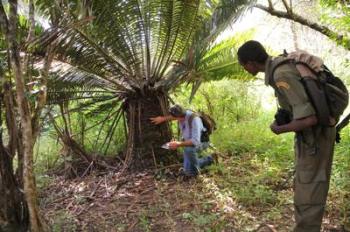 The Mathews cycad. Photo courtesy of: Paula Kahumbu. |
Paula Kahumbu: The Mathews cycad is a bizarre palm like plant that is unique to this particular mountain and it’s forest. It is a huge plant with spreading fronds, and a stem that seems to be made up of massive scales. Its fruit are beautiful. This is one of those species leftover from the Jurassic period—a very ancient species.
The tree is found only here making these forests particularly unique. We saw specimens that were estimated to be over 800 years old. The seeds are dispersed by elephants and the flowers are pollinated by a unique weevil, which just goes to demonstrate how closely interlined the plants and animals are.
CONSERVATION
Mongabay: What is the current status of Mathews Range by the Kenyan government? Is it protected in any way?
Paula Kahumbu: The Mathews are not within any government legislated conservation area but it is being sort of managed by a community initiative, the Namunyak Conservancy. The success of the conservancy depends on its ability to know what is there and how to protect and manage it, which makes this work so critical, as it will justify the creation of a conservation area to protect these unique forests.
Mongabay: Has exploration for oil by Chinese firms affected the Mathews Range?
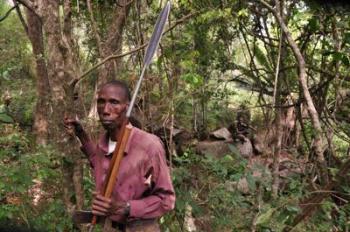 Ranger in the Mathews Range. Photo courtesy of: Paula Kahumbu. |
Paula Kahumbu: Exploration for oil has led to the creation of a major highway that passes close to the Mathews range. So far the impact on the forests has been minimal, but it is clear that the road could be a godsend or a disaster. Logging trucks use the road to exploit the forests and decimate them as has happened in other areas. Alternatively, the road could lead to economic benefits for the communities who live in the area and for tourism development. The Mathews have been left alone precisely because they have been inaccessible except by helicopter or camel!
The expectation that oil will be found in the north of Kenya combined with plans to exploit opportunities in southern Sudan has led to a decision to a national development plan to turn the town of Isiolo, which is just south of the Mathews, into a resort city complete with casino’s, hotels and airports. Whether this bizarre plan takes off or not is almost moot: the speculators are already sniffing around for properties to develop. This is a huge threat because the communities in Northern Kenya are so vulnerable due to poverty.
THE SAMBURU PEOPLE
Mongabay: Will you tell us about the people who live around the range?
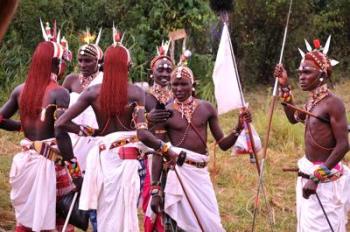 Samburu people dancing. Photo courtesy of: Paula Kahumbu. |
Paula Kahumbu: This part of Northern Kenya is occupied by the Samburu people who are very much like the Maasai. As pastoralists, their way of life involves herding cattle, goats and sheep. They live off the land and hardly cultivate. But they are a proud and beautifully ornate tribe and the men ironically preen themselves to a much greater extent than women. They are known for their fierce warriors and the area is renowned for the inter-tribal conflicts that occur and cattle raiding. Like many tribes in Africa the women are particularly unempowered and are often married off as young girls, female genital mutilation is normal though illegal (nearly 100% of girls are cut), and women do not own anything. Northern Kenya is largely neglected by central government and remains undeveloped, and lacks schools and health facilities. Consequently, the population is under educated compared to the rest of Kenya, and largely impoverished.
Mongabay: Are the Samburu people a threat to the ecosystem or its protectors?
Paula Kahumbu: The Samburu are both protectors and a threat. Their traditional way of life holds great respect for nature, but they are increasingly squeezed due to population growth and development, and some aspects of their tradition are outright detrimental. For example boys are encouraged to kill lions, which is destroying one of their most sellable assets for tourism. And women are not schooled and are encouraged to marry young thus entrenching poverty. In addition their aspirations are understandably changing and so too will their culture. Eking a living off the land can only be sustainable with low population levels and low technology. Things are changing and the Samburu are changing too. The challenge is to tap into the traditional values and make it a part of the survival of the area and the people.
Mongabay: How is the pursuit of honey imperiling the ecosystem?
Paula Kahumbu: Honey is a valuable resource for the Samburu and wild bees are smoked out of their hives which are usually in mature trees. This often means cutting into the trees, and creating fires, which often get out of control. We saw much evidence of previous fires that clearly destroyed large patches of forests. Since the forests are so ancient, any damage like that will have lasting impact. The Samburu claim to have great knowledge of the forest and employ a great number of species for medicine, this tradition can be a great opportunity to engage conservation because of the obvious benefits realized.
Mongabay: Will it be possible to balance protecting the ecosystem and the needs of Samburu people?
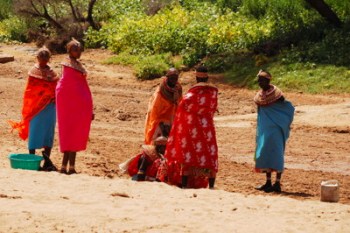 Samburu women fetching water. Photo courtesy of: Paula Kahumbu. |
Paula Kahumbu: I believe that it will be possible to balance the needs of the people and the ecosystems if managed strictly and with complete understanding and agreement. But working with communities is easier said than done as communities are made up of individuals each with their own aspirations. I spoke to a young Samburu man who has been studying at Hawaii University, he told me that his parents have no concept of what he is doing and this is a real catch-22 problem. The educated youth could hold the key to changes, but the culture does not allow youth to advise elders. Sammy told me that he could not in a million years tell his father anything. The Samburu still hold their culture so firmly that only an older person can tell a younger person something. The youth are still raised in a very traditional way and so the system is entrenched.
Mongabay: Can you tell us about the Northern Rangelands Trust (NRT)? How is this group working to save the area?
Paula Kahumbu: The Northern Rangelands Trust (NRT) is a local initiative that aims to ensure sustainable development by collaborating with local community land owners and ensuring the conservation, management and sustainable use of the natural resources within the Trust Area;
The NRT helps with income generation by promoting and developing tourism and all other environmentally sustainable income-generating projects within the Trust and alleviating poverty through improved social services, provision of employment and establishment of community-based enterprises.
Mongabay: If people are interested is it possible to visit the Mathews Range?
Paula Kahumbu: It is possible to visit the Mathews range by booking through the Namunyak conservancy there are high end camps in the mountains as well as options of camel safari’s through the mountains following ancient trading routes.
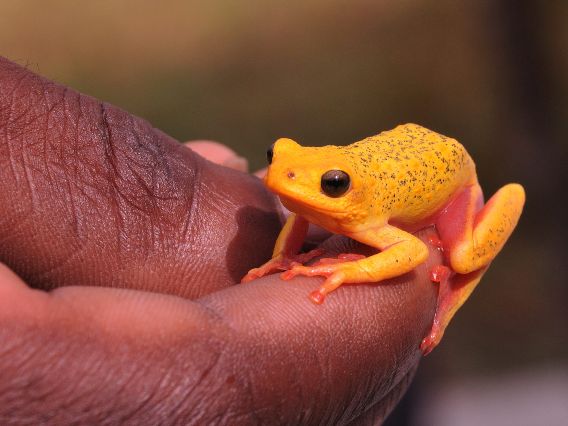
Researcher examines a yellow frog in the Mathews Range. Photo courtesy of: Paula Kahumbu.
Related articles
Photos: more new species found in Indonesia’s ‘lost world’

(05/17/2010) The Foja Mountains on the Indonesian side of New Guinea have proven a biological treasure trove that just keeps spilling riches. Two-and-a-half years ago the region—dubbed Indonesia’s ‘lost world’—made news globally when researchers announced the discovery of a giant rat: five times the size of the familiar brown rat. New amphibians, birds, and insects have also been found during past expeditions in 2005 and 2007. A collaborative team of Indonesia and international researchers have since returned to the Foja Mountains and found more spectacular species.
Photos: expedition in Ecuador reveals numerous new species in threatened cloud forest

(01/14/2010) An expedition into rainforests on Ecuador’s coast by Reptile & Amphibian Ecology International (RAEI) have revealed a number of possible new species including a blunt-snouted, slug-eating snake; four stick insects; and up to 30 new ‘rain’ frogs. The blunt-snouted snake, which feeds on gastropods like slugs, is especially interesting, as its closest relative is in Peru, 350 miles away. In addition, a fifteen-year-old volunteer with the organization found a snake that specializes on snails. The researchers are unsure of this is a new species: the closest similar snake is 600 miles away in Panama.
Forgotten species: discovering the shimmer of Maathai’s Longleg

(01/13/2010) Few species receive less respect and less conservation attention than insects. This despite the fact that they are some of the most diverse species on the planet andthey provide a number of essential services to humankind, including pollination, pest control, production (for example honey and silk), waster recycling, and indications of habitat health. Scientists are not only unsure just how many species of insects are threatened in world; they are equally uncertain how many insects exist. Currently there are nearly a million insect species described by science, but millions more likely exist. It’s probable that innumerable insect species have vanished before even being catalogued by entomologists.
Photo of new chameleon species discovered in Tanzania
(11/23/2009) Researchers have discovered a new species of chameleon in southern Tanzania.
NASA satellite image reveals extent of drought in East Africa
(11/05/2009) A new image from NASA shows the severity of the drought in East Africa, which impacted Tanzania, Kenya, Ethiopia, and Somalia.
Kenya’s pain, part two: decades of wildlife decline exacerbated by drought

(10/20/2009) Not many years ago if you were planning a trip to Africa to see wildlife, Kenya would be near the top of the list, if not number one. Then violent riots in late 2007 and early 2008 leaving a thousand dead tarnished the country’s image abroad. When calm and stability returned, Kenya was again open for tourism, and it’s true that most travelers were quick to forget: articles earlier this year announced that even with the global economic crisis Kenya was expecting tourism growth. However, a new disaster may not be so quickly overcome.
Kenya’s pain: famine, drought, government ambivalence cripples once stable nation

(09/17/2009) Kenya was once considered one of Sub-Saharan Africa’s success stories: the country possessed a relatively stable government, a good economy, a thriving tourist industry due to a beautiful landscape and abundant wildlife. But violent protests following a disputed election in 2007 hurt the country’s reputation, and then—even worse—drought and famine struck the country this year. The government response has been lackluster, the international community has been distracted by the economic crisis, and suddenly Kenya seems no longer to be the light of East Africa, but a warning to the world about the perils of ignoring climate change, government corruption, and the global food and water shortages.
New species everywhere in Papua New Guinea’s ‘lost’ volcano
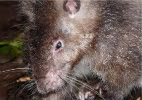
(09/07/2009) A five week expedition into a remote extinct volcano has uncovered a treasure trove of new species in Papua New Guinea, including what may be the world’s largest rat, a fanged frog, and a grunting fish. In all the expedition estimates it may have found around forty species unknown to science. The expedition was undertaken by a BBC film crew and scientists in January. Local trackers led them into the unexplored jungle, hidden beneath the Bosavi volcano’s 2,800 meter summit. Six months prior to arrival, fields of spinach and sweet potato were planted to feed the expedition in such a remote area.
Lion population in Kenya could disappear in 10 to 20 years
(08/20/2009) The Kenyan Wildlife Service recently announced that massive declines in lion population may lead to their disappearence from the region within less than 2 decades. Kenya currently has an estimated 2000 lions, but is losing the large cats at a rate of around 100 each year.
Photos: hundreds of new species discovered in Himalayan region, threatened by climate change

(08/10/2009) Scientists from a variety of organizations have found over 350 new species in the Eastern Himalayas, including a flying frog, the world’s smallest deer, and a gecko which has walked the earth for 100-million-years, according to a new report by the World Wildlife Fund (WWF). The report, entitled Where World’s Collide, warns that these rare biological treasures, as well as numerous other species, are threatened in the Eastern Himalayas by climate change.